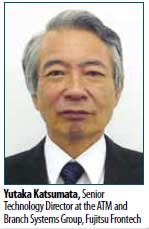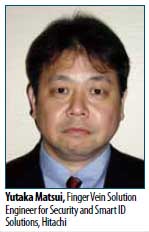Vertical Focus
It can be expected that biometric usage in government services will grow continuously in the near future, said Irmantas Naujikas, Director of Business Development for Neurotechnology. “Civil registry, national ID, voting and border control are typical projects in which personal identification is needed. Biometric and multibiometric technologies ensure better identification of the person and, more importantly, ensure that the same person will not be enrolled several times in the system. For such applications, the reliability and speed of identification are critical.”
For Bio-Key, growth is coming from three areas: health care, retail and government. “Health care is leading the charge, mainly prompted by drivers such as compliance regulations,” Mahnken said. “Time and attendance and transaction tracking using biometric technology make retailers more efficient. The government is also a biometric customer. Just this past year, the FBI launched its new next-generation ID system, which includes our fingerprint software.”
The education market, especially colleges and universities, is a major user of biometrics, especially at recreation centers and residence halls, and on the entries to research laboratories and other areas containing high-value assets, Toscano added. Gaming is another area of focus. “Casinos typically place hand geometry readers at the main cage, at satellite cages and at ‘mantrap' areas, where individuals gain access with the hand reader are then additionally verified with a camera, and only then let through the door. At the slot operations area, a networked hand reader will tie into a key box, a key management system designed to prevent lost or stolen keys.”
 Government and financial institutions are particularly visible on Fujitsu's radar. “Adoption rates of palm vein readers at government offices, banks, branches and ATMs have been quite high in the last year or so,” said Yutaka Katsumata, Senior Technology Director at the ATM and Branch Systems Group, Fujitsu Frontech.
Government and financial institutions are particularly visible on Fujitsu's radar. “Adoption rates of palm vein readers at government offices, banks, branches and ATMs have been quite high in the last year or so,” said Yutaka Katsumata, Senior Technology Director at the ATM and Branch Systems Group, Fujitsu Frontech.
The new kid on the block — cloud concept and related services — is also driving the use of biometrics. Large data center installations, such as at Bell South, Equinix, Google, IBM, Level 3, Microsoft, Qwest Communications, Siemens, XO Communications and Yahoo, use biometric hand readers at the entrance, on the security corridor and on the individual customer areas of their data centers, Toscano said. “Administration of the system is handled by software, which includes features tailored for this type of application like import/export and remote enrollment for multifacility management and expiring privileges for temporary access.”
Recent Advances
While there is no significant, brand-new breakthrough in biometric technology, advances have been made in read accuracy/speed balance and software sophistication.
“In particular, new subdermal scanners have greatly improved enrollment speed and success by negating the effects of poor skin or environmental conditions,” Kendall said. Multispectral technology is more accurate than optical fingerprint reading/matching, Skiba echoed. “We believe light-emitting sensor technology will be more tolerant of the environment (such as backlight) and a better, smaller form factor.”
Newer products have been designed to address growing speed and accuracy issues. “For example, our solution can match 100 million fingerprints or 200 million irises per second,” Naujikas said. “Accuracy is ensured by combining multimodal biometrics, such as fingerprint, face, iris and voice.”
 In finger vein authentication, 1-to-N sequential fusion is now possible, to improve the speed and accuracy when ambiguities in read results arise and a second or third finger is required, said Yutaka Matsui, Finger Vein Solution Engineer for Security and Smart ID Solutions, Hitachi. “Finger vein authentication offers accuracy, speed, high availability and ease of use, and is proved difficult to counterfeit or clone.”
In finger vein authentication, 1-to-N sequential fusion is now possible, to improve the speed and accuracy when ambiguities in read results arise and a second or third finger is required, said Yutaka Matsui, Finger Vein Solution Engineer for Security and Smart ID Solutions, Hitachi. “Finger vein authentication offers accuracy, speed, high availability and ease of use, and is proved difficult to counterfeit or clone.”
In palm vein authentication, false-acceptance rates can now reach 0.00008 percent. “Palm vein technology has cost advantages because the basic mechanism consists of camera technology and IR illumination technology, which are both progressing and readily available. Other advantages include nontraceable and contactless features, as well as reliable and intuitive operation,” Katsumata said. With hand geometry, one key to success in commercial applications is achieving an appropriate balance between the false-acceptance and false-rejection rates, Toscano said.
“That's why hand geometry is used in so many high-throughput applications, in which there is no time for a person to try over and over to get a read.”
In the case of iris scanners, high-performance models now provide the ability to accurately scan an iris from a greater distance and while the subject is moving, Kendall added.
 The starting point for any back-end system is the ability to get a reliable and high-quality image, which requires sophisticated matching algorithms. For example, solutions now need to reach out to Windowsbased applications with a high degree of reliability and performance, to bridge data from desktops, time-and-attendance terminals, PoS kiosks and other devices, said Phil Scarfo, Senior VP of Worldwide Sales and Marketing, Lumidigm.
The starting point for any back-end system is the ability to get a reliable and high-quality image, which requires sophisticated matching algorithms. For example, solutions now need to reach out to Windowsbased applications with a high degree of reliability and performance, to bridge data from desktops, time-and-attendance terminals, PoS kiosks and other devices, said Phil Scarfo, Senior VP of Worldwide Sales and Marketing, Lumidigm.
Software is by far the key differentiator, Skiba agreed. “Software enables different approaches to ease of use, transmission, aggregation of data and powerful analysis.”
Wireless transmission is another focus of development. “Rather than storing biometrics on a server and distributing them over a wired network, a contactless smart card-based system allows biometric templates to be carried by the card holder (match on card) or matched to a previously enrolled template by a trusted host application (match on host), offering a stronger level of authentication and security,” said Jordan Cullis, Sales Director of Identity and Access Management Solutions for Australia and New Zealand, HID Global (an Assa Abloy company).